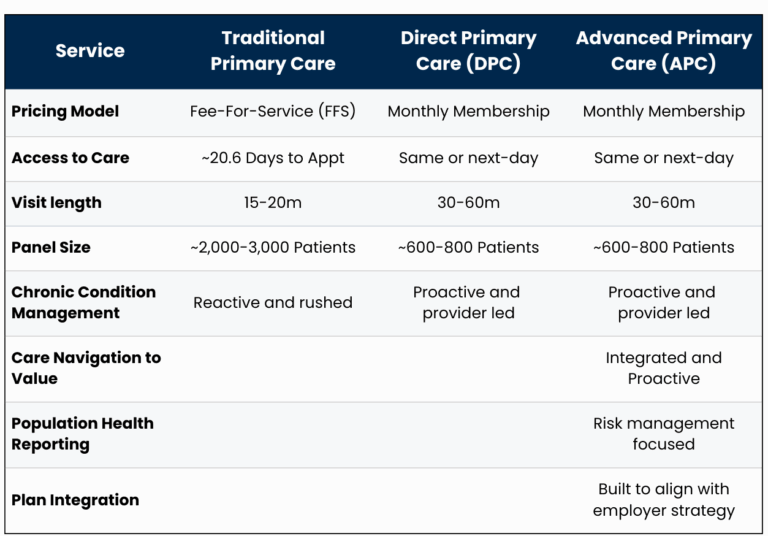By: John Hsieh
Published: Aug 29th, 2025
Primary care is evolving beyond the traditional fee-for-service model. Direct Primary Care delivers access and stronger patient relationships, while Advanced Primary Care builds on that foundation for employers.

Primary care in the United States is at a crossroads. Traditional models leave patients waiting weeks for appointments, sitting through rushed 15-minute visits, and navigating a system that often prioritizes volume over value. Employers face the added challenge of rising healthcare costs without clear improvements in employee health.
In response, Direct Primary Care (DPC) has grown rapidly as a model that delivers longer visits, easier access, and stronger patient-provider relationships. It first gained traction among individuals and families seeking a better healthcare experience outside of insurance-driven primary care. As employers began to adopt DPC for their workforces, a newer approach called Advanced Primary Care (APC) started to take shape. APC builds on the foundation of DPC but is designed with employers in mind adding capabilities like care navigation, population health reporting, and benefit plan integration to achieve measurable business results.
Direct Primary Care (DPC) is a membership-based primary care model where patients pay a flat, recurring monthly fee for unlimited access to their primary care provider. This includes same-day or next-day appointments, 24/7 communication through phone, text, or email, and visits that often last 30 to 60 minutes. By keeping patient panels much smaller than in traditional practices, DPC physicians can focus on building stronger relationships and delivering more personalized care.
DPC takes care of most everyday healthcare needs, but it is not a replacement for health insurance. Patients still need coverage for hospitalizations, specialty care, or major procedures, making DPC a complement to insurance rather than a substitute.
Advanced Primary Care (APC) is an evolution of Direct Primary Care that focuses on the needs of employers and their workforces. Like DPC, it is built on a foundation of smaller patient panels, longer visits, and unlimited access to providers. What makes APC different is the way it expands those principles to address population health and business outcomes.
It is also worth noting that while some DPC practices explore capabilities such as population monitoring or care navigation, these are challenging to deliver consistently. Proactive management of an entire workforce requires advanced tools, data integration, and dedicated resources that go beyond the traditional scope of DPC. For example, evaluating the quality and cost of downstream care or guiding patients through a fragmented healthcare system demands infrastructure that is not common in most independent practices.
Where DPC is primarily centered on the individual patient, APC adds capabilities that align with employer goals. These include care navigation, which helps employees access the right care at the right time, population health reporting, which tracks risk and utilization across an entire workforce, and plan integration, which connects primary care with broader benefit strategies. Together, these elements make APC not just a healthcare model but a framework for improving outcomes while controlling costs.
Care navigation is the process of guiding patients to the right level of care, at the right place, and at the right cost. In today’s healthcare system, employees are often left to make these decisions on their own, which can lead to unnecessary ER visits, redundant testing, or referrals that drive up costs without improving outcomes.
For employers, effective care navigation is critical. It not only helps employees avoid confusion and delays, but also ensures that healthcare dollars are being spent wisely. By steering patients toward high-quality, cost-effective options, care navigation reduces waste while improving the overall experience.
Population Health Management is the practice of tracking participation, utilization, and risk across an entire workforce to understand how employees are engaging with healthcare. Without it, employers have little visibility into whether primary care is improving outcomes or reducing costs.
For employers, effective population health reporting is essential. It highlights trends in chronic conditions, identifies opportunities for early intervention, and provides the data needed to evaluate return on investment. By turning raw healthcare usage into actionable insights, population health reporting enables better decisions for both employees and the business.
Plan integration means that primary care is not just an add-on to an employer’s health plan but a core part of it. Instead of operating in a silo, Advanced Primary Care connects directly with the benefit design, taking into account approved provider networks, drug formularies, and covered services.
For employers, this alignment ensures that primary care decisions reinforce the strategy of the health plan rather than working around it. Physicians can guide employees to in-network specialists, prescribe medications that are covered, and coordinate care in ways that reduce waste and confusion. By integrating with the plan itself, APC makes primary care a central driver of cost control, compliance, and employee satisfaction.

Choosing between Direct Primary Care and Advanced Primary Care depends on your needs and the size of your organization. For individuals, families, and small employers, DPC offers an accessible, affordable, and relationship-centered solution that delivers excellent value without the complexity of insurance-based care.
As workforces grow, the challenges change. Once an employer reaches roughly 100 to 150 employees, the need for population-level management becomes more pressing. Larger groups face higher rates of chronic conditions, more complex benefits administration, and greater financial risk from unmanaged care. This is where APC shines. By integrating with health plans, navigating employees to cost-effective options, and reporting on utilization and outcomes, APC provides the scale and accountability that larger employers require.
While there is no single cutoff, the general rule is that smaller employers thrive with DPC, while larger employers benefit from APC. Understanding where you fall on that spectrum will help you choose the model that aligns with your goals and ensures the best return on investment.
Both Direct Primary Care and Advanced Primary Care represent a shift away from the traditional fee-for-service system that has left patients frustrated and employers burdened with rising costs. Each model delivers more time with providers, improved access, and stronger relationships. The difference lies in scope.
DPC excels for individuals, families, and smaller employers that want simple, transparent access to high-quality care. APC builds on that foundation for larger organizations, adding the navigation, reporting, and plan integration needed to manage risk across an entire workforce.
As healthcare continues to evolve, the question is not whether DPC or APC is better, but which one is the right fit for your situation. By understanding the strengths of each model, employers can choose the approach that best supports their people and delivers measurable results for their business.
With DPC now officially compatible with HSAs, there’s never been a better time to take control of your healthcare.
Join SALTA today or schedule a free consultation to see how Direct Primary Care can work for you.
John Hsieh is the Director of Growth at SALTA Direct Primary Care and the Michigan Chapter Lead for the Free Market Medical Association (FMMA). He is passionate about transforming healthcare through patient-centered models like DPC and works closely with employers, brokers, and clinicians to drive cost-effective, high-quality care.